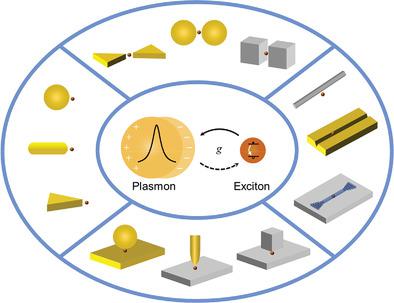当前位置:
X-MOL 学术
›
Adv. Funct. Mater.
›
论文详情
Our official English website, www.x-mol.net, welcomes your feedback! (Note: you will need to create a separate account there.)
Plasmon–Exciton Interactions: Spontaneous Emission and Strong Coupling
Advanced Functional Materials ( IF 19.0 ) Pub Date : 2021-09-12 , DOI: 10.1002/adfm.202100889 Hong Wei 1, 2 , Xiaohong Yan 1, 3 , Yijie Niu 1, 4 , Qiang Li 5 , Zhili Jia 6 , Hongxing Xu 4
Advanced Functional Materials ( IF 19.0 ) Pub Date : 2021-09-12 , DOI: 10.1002/adfm.202100889 Hong Wei 1, 2 , Xiaohong Yan 1, 3 , Yijie Niu 1, 4 , Qiang Li 5 , Zhili Jia 6 , Hongxing Xu 4
Affiliation

|
The extraordinary optical properties of surface plasmons in metal nanostructures provide the possibilities to enhance and accelerate the spontaneous emission, and manipulate the decay and emission processes of quantum emitters. The extremely small mode volume of plasmonic nanocavities also benefits the realization of plasmon–exciton strong coupling. Here, the progress on the study of plasmon modified spontaneous emission and plasmon–exciton strong coupling are reviewed. The fundamentals of surface plasmons and quantum emitters, and the methods for assembling coupling systems of plasmonic nanostructures and quantum emitters are first introduced. Then the major aspects of plasmon modified spontaneous emission, including emission intensity, lifetime, spectral profile, direction, polarization, and energy transfer are reviewed. The coupling of quantum emitters and plasmonic waveguides is then discussed. Next, the developments of strong coupling between plasmonic structures and various quantum emitters are reviewed. Finally a few applications are highlighted followed by conclusions and outlook.
中文翻译:

等离子激子相互作用:自发发射和强耦合
金属纳米结构中表面等离子体的非凡光学特性为增强和加速自发发射以及操纵量子发射器的衰减和发射过程提供了可能性。等离子体纳米腔的极小模式体积也有利于实现等离子体激子强耦合。在此,综述了等离子体修正自发发射和等离子体激子强耦合的研究进展。首先介绍了表面等离子体和量子发射器的基本原理,以及组装等离子体纳米结构和量子发射器耦合系统的方法。然后回顾了等离子体修改自发发射的主要方面,包括发射强度、寿命、光谱分布、方向、极化和能量转移。
更新日期:2021-09-12
中文翻译:

等离子激子相互作用:自发发射和强耦合
金属纳米结构中表面等离子体的非凡光学特性为增强和加速自发发射以及操纵量子发射器的衰减和发射过程提供了可能性。等离子体纳米腔的极小模式体积也有利于实现等离子体激子强耦合。在此,综述了等离子体修正自发发射和等离子体激子强耦合的研究进展。首先介绍了表面等离子体和量子发射器的基本原理,以及组装等离子体纳米结构和量子发射器耦合系统的方法。然后回顾了等离子体修改自发发射的主要方面,包括发射强度、寿命、光谱分布、方向、极化和能量转移。


























 京公网安备 11010802027423号
京公网安备 11010802027423号